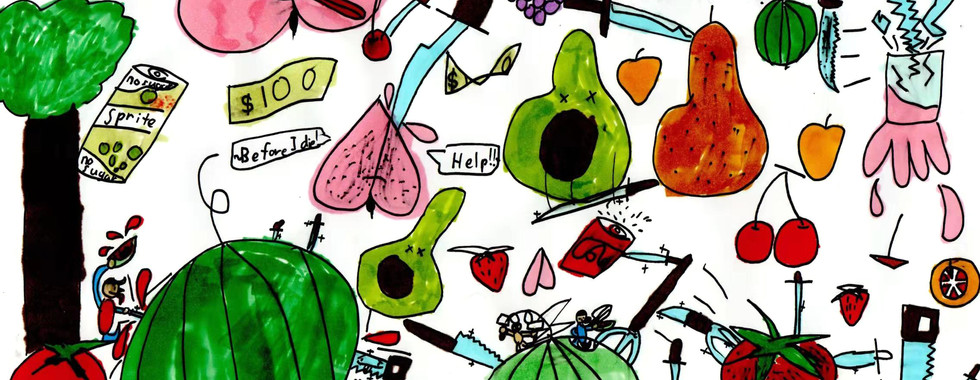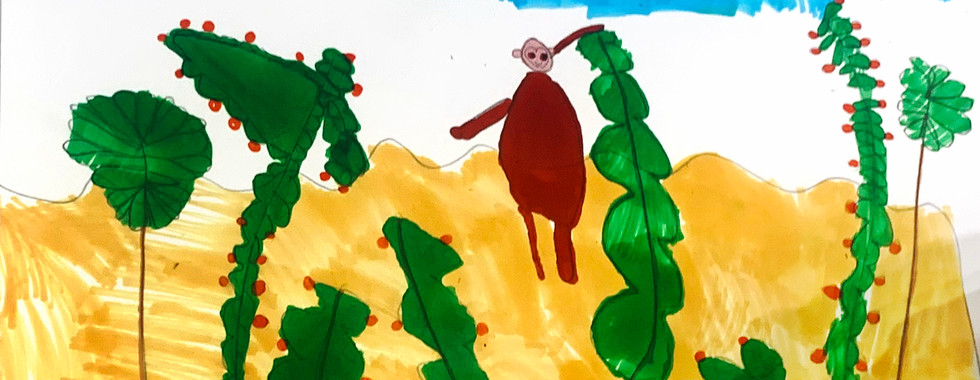Why Are Art Instructions Stifling Children's Artistic Talent?
- Faye Z

- Jan 24, 2022
- 4 min read
Updated: Feb 2

Picasso once said, "Every child is an artist. The problem is, how do they remain an artist once they grow up?" This is probably one of Picasso's most famous quotes—and likely also the most-used slogan by art centres. They put it up on the walls, on their websites, and on flyers advertising art courses. Even parents who’ve never considered that their children might have artistic talent may find it hard to resist the idea that their kids could become as famous an artist as Picasso—only if they attend one of these centres. However, when you look at the artworks on display, it becomes apparent that those who put up this quote don't seem to appreciate children's art as much as they'd like to think.
In these art centres, art is taught to young children in a rigid and structured manner. If you're not sure what I’m referring to, I’m sure you've seen a photo post on social media—children smiling in the same way, each holding a piece of artwork that looks as if they were celebrating similarity. Yes, these artworks came from little hands—probably with a hidden big hand from their teachers—but they are strikingly alike, almost as if they rolled off the same assembly line during the early time of Industrial Revolution.
Of course, some art centres oppose this approach. What they do is provide children with a basic framework and a set of steps to follow, then encourage them to add their own bits and pieces here and there, proudly announcing, "We are preserving children's creativity."
Parents—who aren’t necessarily equipped with the knowledge to determine whether an art centre's philosophy is authentic—are usually pleased with what their kids bring home: artwork that is neat, presentable, and shows a level of complexity—something the kids couldn’t have produced on their own at home.
In my art tutoring practice, I often have parents of young children ask me, "Could you teach them sketching and how to draw more realistically?" Explaining why that’s not always the best approach can be just as challenging with parents as it is with many art teachers. Some argue, "If kids need lessons to play the piano, why shouldn’t they be taught visual art skills?" or "Without a foundation, how will they know how to turn their imagination into shapes?"
Here’s what I believe: Art is intrinsic to young children, and their creations have value on their own. Teaching technical skills too early can do more harm than good.
Don't get me wrong—I’m not saying kids shouldn’t learn skills at all. What I wanted to say is that skills shouldn’t be drilled through a rigid curriculum. Instead, they should come naturally—when a child is ready, interested, and when those skills help bring their ideas to life, not the other way around.
When Picasso said, "Kids are born artists," he clearly wasn’t talking about technical skills. What he meant, at least the way I see it, is that kids have a natural freedom to express themselves. Give them a pencil, and they’ll create without hesitation—spontaneously, joyfully, and without worrying about the end result.

Let’s imagine a child spotting a bird—watching how it moves, how its wings catch the light. He feels something stir inside him, an urge to capture the moment. But words don’t quite do it, so instead, he picks up a pencil and lets his hands do the talking—just like a poet who feels the need to write a poem before the feeling fades. It’s as natural and effortless as a bird singing.
He doesn’t need to know the bird’s anatomy or how to draw perfect lines, and he couldn’t care less if his drawing looks impressive. All that matters is channeling that moment of inspiration onto paper. His work might lack detail, seem unfinished, or even look abstract, but through his lines and colours, we see something real—his raw, unfiltered response to the experience. To him, the bird isn’t just an object; it’s a fleeting moment, a connection, a piece of life that left an imprint on him. His drawing isn’t about replicating reality—it’s about recreating his experience of life.
That’s why telling kids what their art 'should' look like—and how to make it—is the fastest way to stifle that instinctive creativity.

Why do kids create art this way? Because their brains don’t work like ours. To them, there’s no clear divide between their inner world and the outside world—it’s intertwined. What they put on paper isn’t just a picture; it’s their experience, exactly as they felt it. And they don’t overthink it. They just create—freely, without doubt, judgment, or worrying about whether it 'looks right'.
This kind of raw, uninhibited expression is something most adults have lost. It’s exactly what Picasso admired and spent his whole life trying to reclaim—and, funnily enough, the very thing many art teachers, with the best of intentions, end up stamping out.
"It took me four years to learn to draw like Raphael, but a lifetime to learn to draw like a child." - Picasso
It’s never too late to pick up skills. In fact, they’re easier to learn once kids reach a certain stage—when their hand-eye coordination improves and they can grasp more complex concepts. But that authenticity, inner freedom, and courage? Once they’re lost, they’re much harder to get back.
That’s why I don’t 'teach' young kids how to make art—I inspire them to explore, express, and create in a way that's align with their own individuality. I believe that knowing how to express themselves through art is something that will stay with them for life, whether they end up as professional artists or not.
Be yourself, everyone else is already taken" -Oscar Wilde,







































Comments